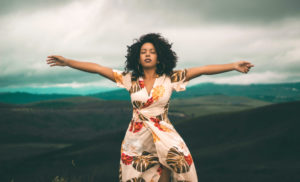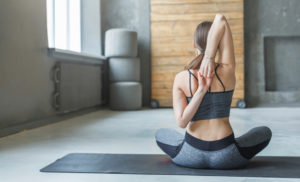by Bridget
Almost exactly a year ago, Nina and I drove down to Santa Barbara to attend an Accessible Yoga Training, led by Jivana Heyman. We spent the long weekend taking an in-depth look at the process of adapting yoga poses for any body, integrating the ancient wisdom of yoga into teaching, and working with mixed-level groups. This is the kind of inclusive work that is at the core of the Accessible Yoga movement.
This week I took a closer look at the Accessible Yoga Blog’s Home Practice Club page, which includes several posts on sequences and pose variations, all focused on making a pose or a practice more accessible for different body types. I was particularly drawn to this chair version of Half Moon pose (Ardha Chandrasana). Teacher Janis Ware breaks down her process for getting comfortably into a version of the pose that works for her body. Her explanations are clear, and she gives a few different options for coming into the pose that eliminate any discomfort that could arise, suggesting additional blocks under the supporting hand, and taking the back leg out of its extended position, allowing the extension of the leg to happen in her “mind’s eye” instead. The chair takes the legs mostly out of the equation, and focuses instead on the core strength and balance that are still needed for this version of the pose.
(If you’re reading this on email, click here to view video.)
Finding alternatives to poses has always been a part of my teaching. I’ve taught Half Moon pose with a foot or a hand on the wall, or with back or front body to the wall for balance. I even have a version of it that starts from hands and knees. But taking the legs entirely out of the pose, as Janis does here, was a new exploration for me. Similarly, what I found at the Accessible Yoga training is that it’s possible to push poses to a new level that really does allow for wider inclusivity. If you’re interested in learning more about Accessible Yoga, you can find the web page here.
Janis Ware, RYT200, is an Accessible Yoga Certified Teacher/Ambassador and is Trauma Informed Yoga and LV Chair Yoga Certified. She teaches in Iowa, in the DesMoines area, including at a holistic wellness center, an adult ed class, a church, a class sponsored by a cancer organization at the Y, and a 55+ retirement community (all currently virtual). Her students have ranged in age from young adult to 97! Nearly all tell her they come to the class because it is adaptive and accessible. They want to feel better in their bodies, minds, and spirits, want to practice yoga and hope they’ve found a safe space to do so. More info on Janis here.
Subscribe to Yoga for Healthy Aging by Email ° Follow Yoga for Healthy Aging on Facebook ° To order Yoga for Healthy Aging: A Guide to Lifelong Well-Being, go to Amazon, Shambhala, Indie Bound or your local bookstore.
by Bridget Almost exactly a year ago, Nina and I drove down to Santa Barbara to attend an Accessible Yoga Training, led by Jivana Heyman. We spent the long weekend taking an in-depth look at the process of adapting yoga poses for any body, integrating the ancient wisdom of yoga into teaching, and working with mixed-level groups. This is the kind of inclusive work that is at the core of the Accessible Yoga movement. This week I took a closer look at the Accessible Yoga Blog’s Home Practice Club page, which includes several posts on sequences and pose variations, all focused on making a pose or a practice more accessible for different body types. I was particularly drawn to this chair version of Half Moon pose (Ardha Chandrasana). Teacher Janis Ware breaks down her process for getting comfortably into a version of the pose that works for her body. Her explanations are clear, and she gives a few different options for coming into the pose that eliminate any discomfort that could arise, suggesting additional blocks under the supporting hand, and taking the back leg out of its extended position, allowing the extension of the leg to happen in her “mind’s eye” instead. The chair takes the legs mostly out of the equation, and focuses instead on the core strength and balance that are still needed for this version of the pose. (If you’re reading this on email, click here to view video.)Finding alternatives to poses has always been a part of my teaching. I’ve taught Half Moon pose with a foot or a hand on the wall, or with back or front body to the wall for balance. I even have a version of it that starts from hands and knees. But taking the legs entirely out of the pose, as Janis does here, was a new exploration for me. Similarly, what I found at the Accessible Yoga training is that it’s possible to push poses to a new level that really does allow for wider inclusivity. If you’re interested in learning more about Accessible Yoga, you can find the web page here.Janis Ware, RYT200, is an Accessible Yoga Certified Teacher/Ambassador and is Trauma Informed Yoga and LV Chair Yoga Certified. She teaches in Iowa, in the DesMoines area, including at a holistic wellness center, an adult ed class, a church, a class sponsored by a cancer organization at the Y, and a 55+ retirement community (all currently virtual). Her students have ranged in age from young adult to 97! Nearly all tell her they come to the class because it is adaptive and accessible. They want to feel better in their bodies, minds, and spirits, want to practice yoga and hope they’ve found a safe space to do so. More info on Janis here.Subscribe to Yoga for Healthy Aging by Email ° Follow Yoga for Healthy Aging on Facebook ° To order Yoga for Healthy Aging: A Guide to Lifelong Well-Being, go to Amazon, Shambhala, Indie Bound or your local bookstore. Read More
Read More







